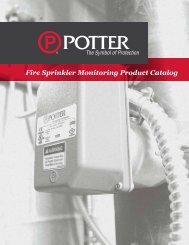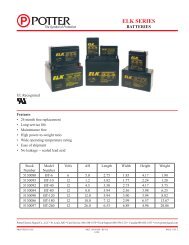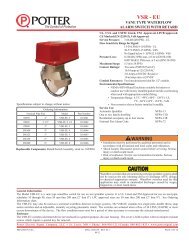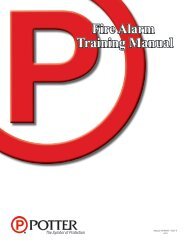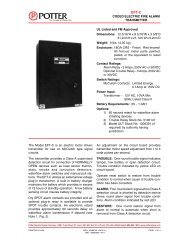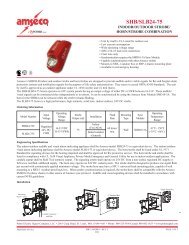Training Manual - Potter Electric Signal Company, LLC
Training Manual - Potter Electric Signal Company, LLC
Training Manual - Potter Electric Signal Company, LLC
Create successful ePaper yourself
Turn your PDF publications into a flip-book with our unique Google optimized e-Paper software.
#3. Wet System With Maintained Excess Pressure<br />
This type of system has a jockey or excess pressure pump that is maintaining a higher pressure on the system<br />
side of the check valve than the supply pressure can be expected to reach. This excess pressure holds the clapper<br />
of the valve down even when the city pressure fluctuates. This eliminates false alarms caused by water surges.<br />
Fig. 5<br />
Wet System With Excess Pressure (Pressure Drop)<br />
Waterflow Alarm Installation<br />
RISER TO<br />
SPRINKLER HEADS<br />
Two different methods utilizing two different waterflow devices can be used to monitor these types of systems.<br />
Excess pressure systems do not require retards on the flow switches.<br />
On both systems the excess pressure pump should be monitored with a supervisory pressure switch. This switch<br />
should be set to trip when the pressure drops 10 psi below normal, this will prevent false alarms due to a drop in<br />
pressure from a pump failure. A typical excess pressure system may maintain a system pressure of 120 psi. The<br />
low pressure supervisory switch would be set to trip at 110 psi. High pressure should be monitored to prevent<br />
damage to sprinkler system and long delay of a waterflow alarm.<br />
PS100-2<br />
WATERFLOW SWITCH<br />
OPERATES ON<br />
PRESSURE DROP<br />
PS120-2<br />
EXCESS PRESSURE<br />
SUPERVISORY SWITCH<br />
BVL<br />
BLEEDER VALVE<br />
(OPEN)<br />
CLAMP TYPE<br />
FITTING<br />
A. Straight Riser With Maintained Excess Pressure<br />
A pressure drop type waterflow device is connected to the system side of the check valve. Activation of a<br />
sprinkler head in the system results in a loss of excess pressure, the pressure will drop down to whatever the<br />
supply pressure is. The waterflow switch detects this drop in pressure and sends an alarm signal.<br />
CHECK<br />
VALVE<br />
BVL BLEEDER<br />
VALVE (OPEN)<br />
EXCESS<br />
PRESSURE<br />
GAUGE<br />
The low pressure supervisory switch is set to trip approximately 10 psi below the normal excess pressure.<br />
The waterflow switch would be set to trip 10 psi below the supervisory switch. The trip point of the waterflow<br />
switch must be higher than the water supply pressure can be expected to reach.<br />
Note: All water control valves should be supervised per NFPA13 2010 8.16.1.1.2.1.<br />
EXCESS PRESSURE<br />
LINE VALVE (OPEN)<br />
DRAIN VALVE<br />
(CLOSED)<br />
OPEN<br />
JOCKEY<br />
PUMP<br />
DRAIN<br />
PIPE<br />
OSY CONTROL<br />
VALVES (OPEN)<br />
WATER<br />
CHECK<br />
VALVE<br />
TAMPER<br />
DEVICE<br />
OSYSU<br />
TAMPER<br />
DEVICE<br />
OSYSU<br />
BALL DRIP VALVE<br />
FIRE DEPT.<br />
CONNECTION<br />
(SIAMESE)<br />
CITY WATER<br />
SUPPLY<br />
CHECK<br />
VALVE<br />
22 23







